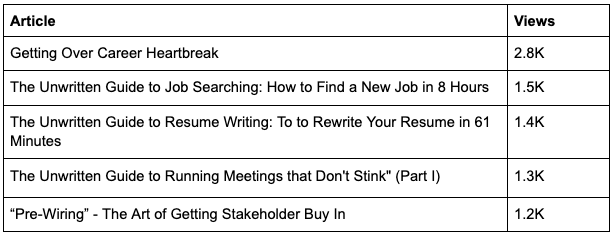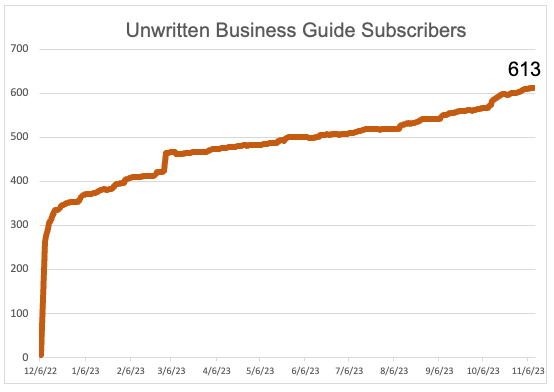The Backstory
Austin and I have always wanted to work together. We have similar careers in strategy and shared aspirations to one day write a book. While we agree there are a myriad of topics the world needs that have yet to be written (hence the Unwritten name), we decided penning a weekly newsletter would be the best way to begin.
We set off one year ago and weekly have experimented with various topics, lengths, co-writing methods, and hooks. It has been a grand adventure. Now, 52 articles in, here’s what we have learned so far.

Articles: What Works vs What We Like
We spent a long time trying to figure out what kind of topics (A) we would enjoy writing about most, and (B) would resonate with our readers. Ultimately we landed on a theme of “Unwritten” type content – heartbreak of not getting a job, how to get a job, how to run a meeting, how to balance work/family, etc.
Essentially we’ve landed on a niche domain of “career topics that have very little to no formal training or content written about them”. These are things that you are expected to just learn on the fly, many people have questions about, but are very top of mind for everyone trying to build a professional life.
There’s heaps of content online that are too general and vanilla to be helpful. We wanted our content to be straightforward, practical, have real examples, and help improve people’s careers. Here’s a look at our top articles:
Unwritten Business Guide Top Articles by Views

Our standout article on career heartbreak really resonated with our readers. It was just a genuine rollercoaster ride of trying to get a job. As we were flooded with inbound messages from readers talking about how much the piece resonated with them, Austin and I were really buoyed up by our community and it’s weeks like that one where it feels like all this work has been worth it. (Note: we LOVE getting your comments/notes/feedback!).
Sometimes we also enjoy writing about topics that are just personal to us / are something we’ve always wanted to write. Here are some of our personal favorite articles and their stats:
Unwritten Business Guide Personal Favorites

These articles were just fun to write, as they are topics we have thought a lot about. For example, our article on Helping Your Spouse Understand Your Career was co-written with our wives and sparked some fascinating discussion in our jobs. Another example is our article on the Ozymandias Principle, as it is deeply profound – showing that regardless of all the work you do, what matters at the end of the day is what your family thinks about you.
We fully realize that views aren’t a great measuring stick; we truly care about the impact an article could have in terms of its helpfulness/insights. Writing has also been a creative outlet for both of us. Austin and I have said many times that we would enjoy writing even if not a single person read our work.
Subscribers
Here’s a graph of our subscribers to date:

We have steadily gained subscribers over time, with mini boosts/spikes from high-performing articles or when we speak in classrooms or conferences.
Now we’ll be fully transparent here – we had both thought we would have thousands of subscribers within a year. Only having 613 is below our expectations, but we also fully acknowledge that we had based our expectations off of nothing.
On the encouraging side we feel that we’ve found a great product-market-fit. We have found our audience to be highly engaged with our content (ex: our email open rates are 50-60%, which is well above the industry standard of 25%), and just need to find a way to scale. Our average post gets about 800 views, and about half of those come from subscribers. Many readers find us through our content getting shared, which has also been surprising to us.
We also now know there is more we could do to bolster readership. To-date our strategy has been really simple. We schedule 1 weekly article to be delivered to our subscribers inbox (via Substack) and then post a link to that article on both of our LinkedIn pages 1x per week. In terms of marketing we’re fairly unsophisticated. As part of our growth efforts we’re working on a few things to speed this up:
- Building a website (coming soon!) which should help with SEO + make it easier for readers to browse through our old articles (many of them aren’t aware they could find old articles on our Substack page)
- Posting content more regularly, such as highlighting or updating previous articles
- Speaking in classrooms/conferences
- Exploring other mediums of sharing, such as Instagram or podcasts
- Writing our first short book (coming soon!)
One last surprise about our subscribers is that in our email portal we can see how engaged each subscriber is. We have about half of our subscribers read our articles from the emails we send and can actually see engagement rate by person. So for those of you who consistently read our articles, we see it and thank you!
Writing Process: Do We Write Together?

When we started our newsletter we were honestly worried about what we would write. Would we have substantial insights to share? How would we differentiate? How long should an article be?
Much like a sculpture being sculpted, we have let the pieces take shape in a natural way. Most of our articles are about 5-minute reads, which is more substantial than a regular news/business article, but shorter than an HBR case study or The Atlantic piece.
Austin and I will take turns being “leads” on our articles. We’ll usually lock our idea in and write a draft, then share it with the other person, get a mountain of feedback/edits, and then refine the article until it is ready for publication. There have been a few articles that we’ve directly co-authored together (ex: “6 Books that Changed Our Lives”) but most weeks we each swap the role of “writer” vs. “editor”.
We’re both planners so this happens the week leading up to an article being published on Thursday mornings. We have a shared G-Drive folder where we save out things like article ideas, article drafts, under review, and published.
We both set aside time to write – for example this article is being written on a Friday night with everyone in Jason’s house asleep. Austin tends to write his articles early in the morning (between 6:30-7:15am) and on Sunday afternoons. Most articles take a few hours plus some commentary/edits from each other. It has been surprisingly easy to incorporate writing into everyday life.
Austin notoriously writes a bit too much (we have sometimes edited out whole sections), and Jason famously writes too concisely (we oftentimes go back and add more detail). Both of us have similar writing styles where our readers are left guessing who wrote which article.
We have found working together to be incredibly rewarding. We are both ramping up our writing abilities, and just the other week we were discussing how much easier it has become over the past year not only to write, but to articulate our ideas in other settings. We have also found myself to be less critical of writers since we now know how hard it can be. There’s a quote I think about often as a content creator (as opposed to just a consumer):
“It is not the critic who counts; not the man who points out how the strong man stumbles, or where the doer of deeds could have done them better. The credit belongs to the man who is actually in the arena, whose face is marred by dust and sweat and blood; who strives valiantly; who errs, who comes short again and again, because there is no effort without error and shortcoming; but who does actually strive to do the deeds; who knows great enthusiasms, the great devotions; who spends himself in a worthy cause; who at the best knows in the end the triumph of high achievement, and who at the worst, if he fails, at least fails while daring greatly, so that his place shall never be with those cold and timid souls who neither know victory nor defeat.” –Teddy Roosevelt, former US President
On this quest we realize our writing ability has yet to hit its crescendo, but we’re in the ring and building that muscle. It has been fun to step into the ring with a friend and try something new.

Biggest Surprise: Building A Personal Brand
Austin and I have discovered it is truly beneficial to have a platform like this to share our ideas. It has led to meeting people we wouldn’t have otherwise, many deep discussions with coworkers/friends/family, and just a higher name recognition in work settings like conferences. I have received more LinkedIn messages this year than the prior 5 years combined.
For anyone considering writing a newsletter this should be a critical factor to consider. We really set out to write a book at some point, and acknowledge our community will be helpful when this comes to fruition, but this is tangential for us. However if your occupation is one that requires you to build up your own brand (ex: career coaching, real estate, etc.) then having a newsletter is a great ticket in.
It feels incredible to be building something we know is adding value in the world, and the fact we’re building our personal brands in lockstep with this is icing on the cake.
Conclusion
Starting this newsletter has been an amazing journey. We are still figuring out what works well (and what doesn’t!) in our ultimate quest to write a book. It has made us better writers, to be more thoughtful as we approach our careers, and further shown us that if you want to see something created you might have to do it yourself.
It’s been an amazing first year and we can’t wait for the second!


